Now & New
Takehara Momoneko-sama Festival 2023: Commemorating the Most Hiroshimarian Anime
Japan’s got a wide spectrum of festivals, with histories of varying lengths and celebrated for every reason imaginable. Of these are some occasions known as “kisai” (奇祭 – odd festivals), and considering how many weird things there are in Japan, if even the local Japanese call a festival odd, you know the festivities are going to be weird as all get out. Naturally, Hiroshima Prefecture has its share of odd festivals: there’s a Kui Naked Man Festival in Mihara every mid-February where dudes in nothing but loincloths battle over a “tree of happiness” at a shrine, and on the first three days of November, Onomichi holds the Betcha Festival, where men dressed as ogres hunt down and beat children with sacred poles to make them smarter and healthier in the coming year. Meanwhile, Takehara’s odd festival is dedicated to Momoneko-sama, the mascot of Tamayura, which was an anime that started in 2011 and took place in Takehara. In the anime, this little pink, fluffy feline lived in the Takehara Historical Preservation District and watched over the townsfolk, and as there are now statues of Momoneko-sama in the real-life Takehara, this character is now treated as a protector god (perhaps satirically) of sorts by the locals, and a festival of him has been held ever since 2012.
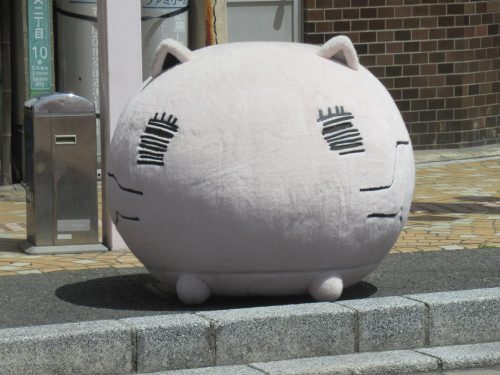
Although eleven years have passed since the inaugural Momoneko-sama Festival, the one held this year was the seventh one ever and the first one held since 2017—that’s a six-year gap, and the first festival since the end of the pandemic. Since the protagonists were starting high school when the series began in 2011 and graduated in 2014, the 2023 festival held on April 22nd portrays more mature versions of the characters in a reunion-type setting. While I only discovered Tamayura when I first visited Takehara back in 2021, I left that series on the back burner for the longest time until this event was announced, then binged the entire series—four OVA episodes, two seasons, and four hour-long films—to make sure I was ready to understand and appreciate everything I would encounter at the Momoneko-sama Festival.
Festival Streets
Despite most of the show’s events taking place in the Historical Preservation District, the festivities were mostly confined to Aifuru-dori 316 (pronounced “san-ichi-roku”), the main shopping arcade of downtown Takehara right in front of Takehara Station. 316 refers to the length of the street being 316 meters long, and “Aifuru (愛降る)” means “falling love,” referring to the locals’ hope that love for their town falls like gentle snow on their cherished 316 meters of local businesses. I definitely felt that love on the day of the festival when almost every shop had Tamayura posters in the windows or life-sized dolls and cardboard cutouts by the front doors.
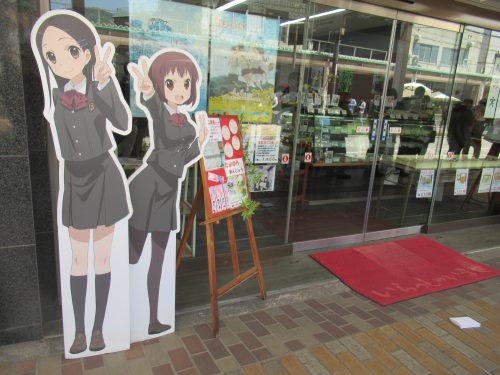
For Tamayura fans nationwide, today was the day to come to Takehara and nab show-related merchandise, as numerous vendors dotted Aifuru-dori 316 and one store even had a queue snaking down and across the street. In an empty lot on the right side was a stage where a talk show featuring Mr. Imaichi, the chairman of the Takehara City council, was underway. It was here that the “Momoneko Ondo,” a parody of the ubiquitous music of Japanese Bon festivals, would be played later in the day, and a nerdy dance party would ensue.
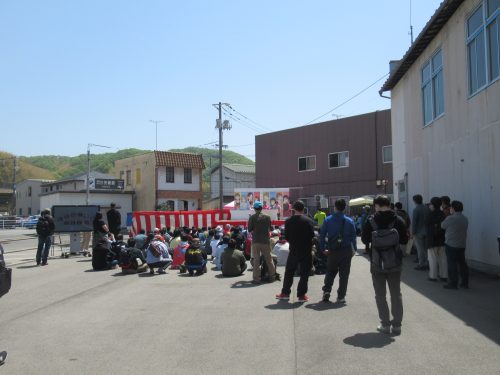
Farther down Aifuru-dori 316 were a shrine dedicated to Momoneko-sama, a jumbo Momoneko-sama doll on wheels that would later be used in the parade, and another empty lot occupied by food trucks. True to the occasion, these trucks sold Momoneko-sama-themed foodstuffs, like pink chocolate-covered donuts with cat ears, in addition to common festival fare like sausages in buns and strawberry smoothies. Songs that appeared in episodes of Tamayura were blaring over the speakers, but there was ample dining space so it was a good spot for guests to wind down while waiting for the dance party or parade to start.
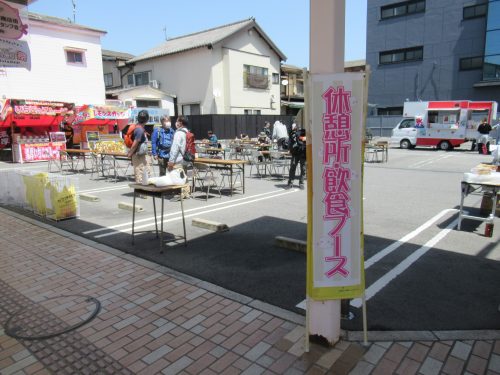
Moment of Joy: Fateful Purchase
I’m usually not one to buy anime merchandise because I have enough clutter at home, but something about the air of the festival and my love for the series made me want to take home at least one Momoneko-sama souvenir. I stopped by a clothing store called Orion to see if I could get my hands on a longer-lasting gift like a T-shirt, and those were being taken up by fans like unattended Halloween candy.
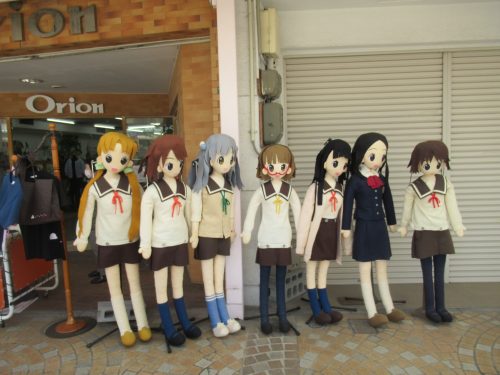
Some of these otakus get pretty big, so after some browsing, I finally found a T-shirt in a color I liked that fit me pretty well, but the only one left in that size was the one on display. I immediately pulled the trigger on it, and they politely packaged it up for me; I felt like a lucky winner as I took the blue shirt off the display rack all for my own.
Inspiration for the Anime
As the real city of Takehara served as the inspiration for most of Tamayura’s episodes, those who are visiting for the Momoneko-sama Festival are likely to want to wander over to the Historical Preservation District to see the real-life models of the anime locations. Before all of that though, my first destination was Roadside Station Takehara, which has an official plaque designating Takehara as an Anime Tourism Spot. The first floor has a gift shop and restaurant, but for us nerds (I use this term lovingly, I swear), the real attraction is the plaque marked “Animation spot” on the first floor, as well as the official Anime Tourism stamp and models of Tamayura manhole covers on the second floor.
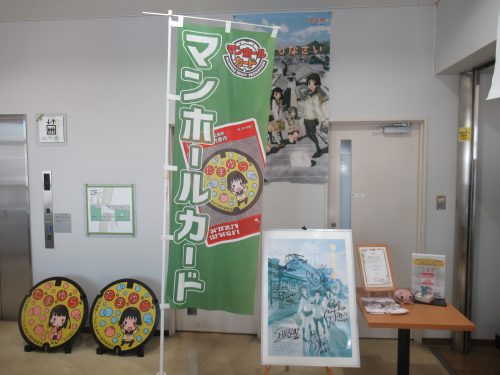
I could’ve sat myself down for a pricey lunch at the restaurant or splurged on carnival fare at the aforementioned food truck corner, but I decided on something more local and humbler: a Takehara Burger from the stand just outside the building. As the name Takehara (竹原) literally means “bamboo field,” which means bamboo shoots have been a typical food here for as long as anyone can remember. The Takehara Burger is packaged in a brown paper wrapper resembling a bamboo shoot, and the sandwich itself contains a beef and potato croquette, a juicy slice of bamboo shoot, some crisp lettuce, and a savory, soy sauce-based dressing. It was on the small side, but I intended to eat more at the Historical Preservation District anyway so I was just biding my time with a quaint Takehara snack.
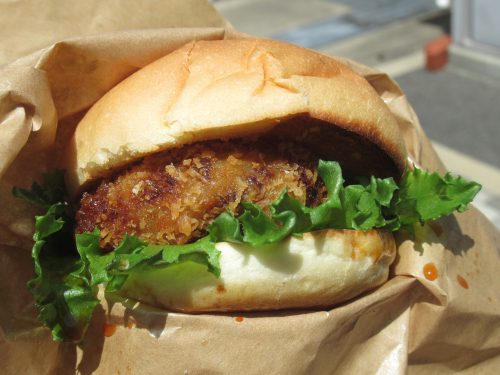
Crossing over the bridge to the old town, the first significant edifice Tamayura lovers will notice is the wooden house marked 日の丸写真舘 (ひのまるしゃしんかん – Hinomaru Photograph Studio), which was a store frequented by protagonist Fu “Potte” Sawatari. Unfortunately, this building has no real business inside, so anime fans just stop here to snap a photo and move on. The curb from the opposite end of the street is the perfect spot from which to take said photo; all I had to do was watch my timing regarding foot and automobile traffic.
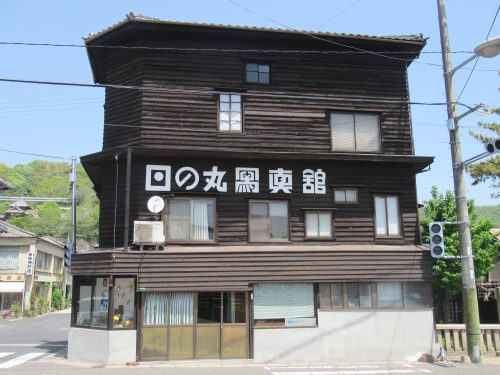
There was a slew of other nods to the series in the Historical Preservation District, such as Café Tamayura, where Fu’s mother and grandmother operated their business, the Old Kasai Residence, where Fu and her friends put on the “Us Exhibition,” and Fumeikaku, a hilltop temple terrace where the characters often met to hang out and contemplate on life. Out of all the homage paid to the show that day, though, the one locale that trumps all others is Horikawa, a beloved okonomiyaki restaurant in real life that pretends to be “HOBORO,” everyone’s go-to okonomiyaki joint in the show. Every time Takehara puts on a Tamayura-related event, Horikawa puts up a HOBORO sign and red curtain, and the majority of anime lovers come here to eat and pretend to be one of the extras on the show.
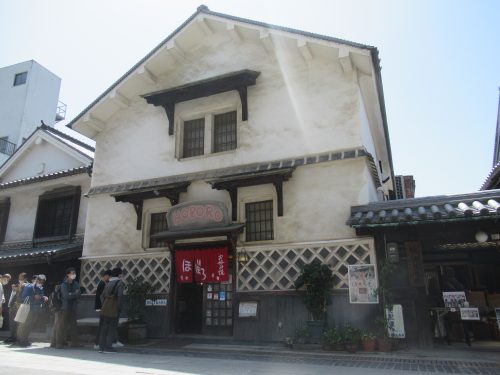
I was a bit hesitant to get in line, but once I did, I was glad I stepped in when I did, because the line only got longer behind me. On the bright side, the long waiting time gave me the opportunity to take pictures and videos of my surroundings, including this complex pinwheel around the corner from the adjacent building. Speaking of bright sides, I was also grateful we were blessed with sunny skies; had it been rainy, I might have foregone lunch here.
The signature item on the menu in the show was the Hoboroyaki, a specialty okonomiyaki exclusive to the establishment whose recipe underwent changes over the years. This is reflected in how the Hoboroyaki in real life changes a little bit (or a lotta bit) every time a Tamayura event happens in Takehara. When I was seated, I saw a diagram on the wall illustrating the Hoboroyaki Revolution, which was a regular soba-filled Hiroshima-style okonomiyaki, with meatballs embedded within, a tuna and corn topping, and a scoop of ketchup-flavored chicken rice on top. Ordering it was a cinch because the server assumed everyone lined up to eat was a Tamayura nerd who wanted the Hoboroyaki.

In addition, this restaurant was also serving up Tamayura character-themed soda floats in nine different flavors, half of which were sold out by the time I got there. I got myself a banana soda just because it sounded so weird, and because the banana flavor was adorned with a paper pick featuring Maon Sakurada, whose voice actress was actually present at the festival for a talk show I couldn’t attend. After a brisk culinary photoshoot, I wolfed down my food and drink, then left the store so subsequent patrons could have a seat.

Throughout the Historical Preservation District that day, there were even more fan-drawn pictures of Tamayura characters as well as cardboard cutouts in front of stores. I passed by the usual tourist sites one would see when coming here, which were also sites the Tamayura cast passed by on their way to school. Considering the occasion and the fact that it was Saturday, I was honestly surprised at how empty the streets were and how easy it was for me to take pictures devoid of people.
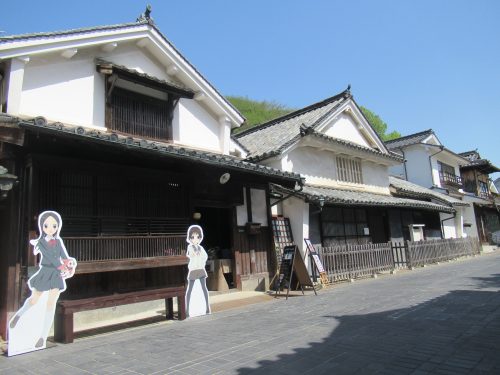
Dance Break
As the clock was fast approaching 2:30 p.m., I knew I had to hurry back to where the talk show was to catch the Momoneko Ondo dance party. There’s a video on YouTube outlining the general steps of the dance, and guests were advised to study and practice in advance to maximize the fun factor. I thought I was running late, but it turned out that the organizers themselves weren’t on time either, which was perfect for me to catch my breath. Shortly thereafter, a mysterious man in a pink bodysuit and Momoneko-sama mask took the stage to liven the mood, and the MC gave a brief explanation before the party started. I watched the YouTube video again and again before we started dancing, but like with any “ondo (traditional dances done at Bon festivals),” participants typically get better through trial and error. Despite dancing to this song countless times, our collective pace in advancing was slow, so the group failed to complete even one circle by the time the party was over.
There was still a lot of time before the main event, the Momoneko Parade, which would take place at around 6:30 p.m. To kill time, I decided to return to the Historical Preservation District for one more burst of sightseeing. Strangely enough, the Takehara Burger and Hoboroyaki I had still left me unsatiated, so I dropped by ICHIE, a traditional Japanese-style café with an eye-catching green awning. There was no one at the front to receive customers, so I removed my shoes, entered the building, and opened the front door to make my presence known and be seated. ICHIE has a quaint interior with the quintessential décor of any Japanese house, such as tatami mats, a wall scroll, and decorative samurai armor in the alcove.

The fare served at ICHIE is mostly sweets and drinks, but as I was craving something savory and more substantial, I went for the “Greedy Drink Set,” which let me order a lemonade to go with some warabimochi, rice crackers, chocolate, Japanese pickles, a parfait with syrup, and two rice balls wrapped in leaves.
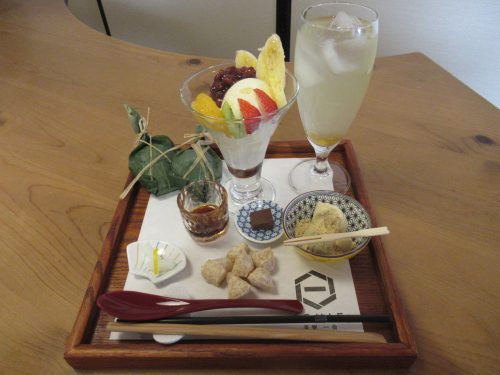
I took my sweet time indulging in my late afternoon snack and stayed until closing time. It was still a good while before the parade would begin, though, so I made my way to the Fumeikaku, an iconic temple terrace in the Historical Preservation District situated at the top of a long staircase. Even this late in the afternoon, there were quite a few people coming and going, so this shot of Fumeikaku with nobody took a long time to obtain but was worth it in the end.
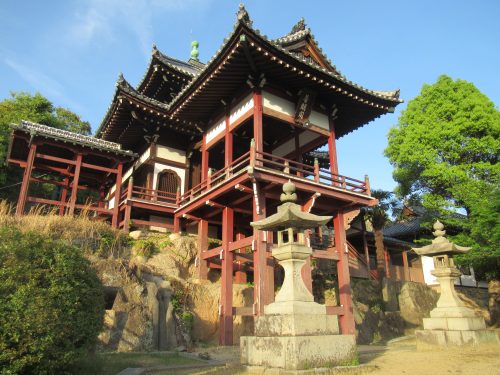
This building had the spotlight in several episodes of Tamayura, being a place where the main characters gathered outside of school to reminisce on the past or contemplate the future. For better or worse, this place isn’t as popular with Takehara teens in real life, which might be better for tourists like yours truly. Oh, well, that just means I could hog this vista until just before the start of the Momoneko Parade.
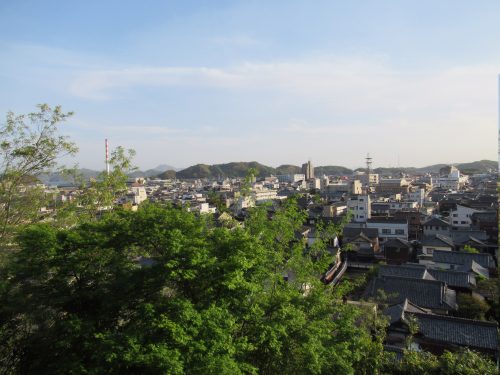
Praise Momoneko-sama!
As I was on my way back to Aifuru-dori 316, I could hear announcements about the parade being broadcast over the loudspeakers. At that moment, Tamayura fans cooped up in nearby restaurants all spawned and migrated like cattle to the street right in front of the station. A woman cosplaying as Maon Sakurada was behind the wheel of a three-wheeled, motorized scooter with a truck bed in the back, and who else would be there but Momoneko-sama, wearing a crown with flashing lights!
Eventually the parade got underway, and between the throngs of people lining Aifuru-dori 316 and the queue of nerds following Momoneko-sama, getting good photos of the parade basically meant joining the parade itself. Simply stepping near the dancing fans swept me into the crowd, and I naturally made my way to the front, where Momoneko-sama was in plain sight and the deafening sound of three silly Tamayura songs on repeat put all of us participants in a trance. All the while, I was aware that all cameras were on us, and since even professional journalists were on the streets and rooftops recording us, the parade ending up on a news site was a matter of time.
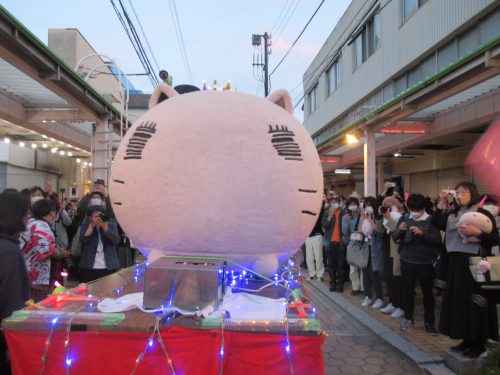
After reaching a certain end of Aifuru-dori 316, the caravan did a 180 and headed back towards Takehara Station. It was there that I made my stealthy escape before the parade proceeded to make an additional round. I wanted to stay, but also wanted to grab a bite to eat before catching a train home at a decent time. As I stepped into Takehara Station, I turned around one last time to see the message greeting all visitors to Takehara.
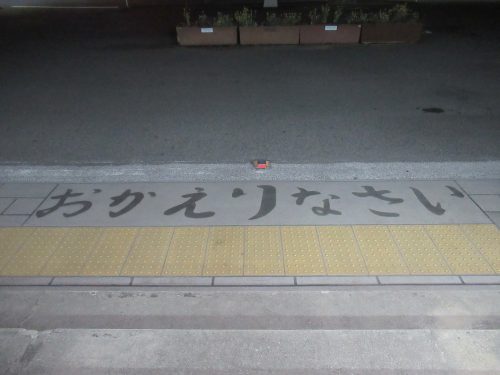
おかえりなさい means “Welcome home,” and is the title of the theme song for Tamayura’s first season. It warms my heart to know that Takehara will welcome me back no matter how many times I drop by, as if I’ve lived there my entire life, and I’m proud to have such a sweet and fun anime represent my prefecture of Hiroshima. Ever since I binged the show prior to my trip, I’ve been obsessed with Tamayura to a certain degree and plan to hit up more Tamayura-related sites in the future. In spite of the novelty and weirdness of the Momoneko-sama Festival, it certainly now has me more invested in getting to know Hiroshima’s smaller towns on a deeper level, which is only fitting for a person who now calls this prefecture home.
Written by the Joy in Hiroshima Team
